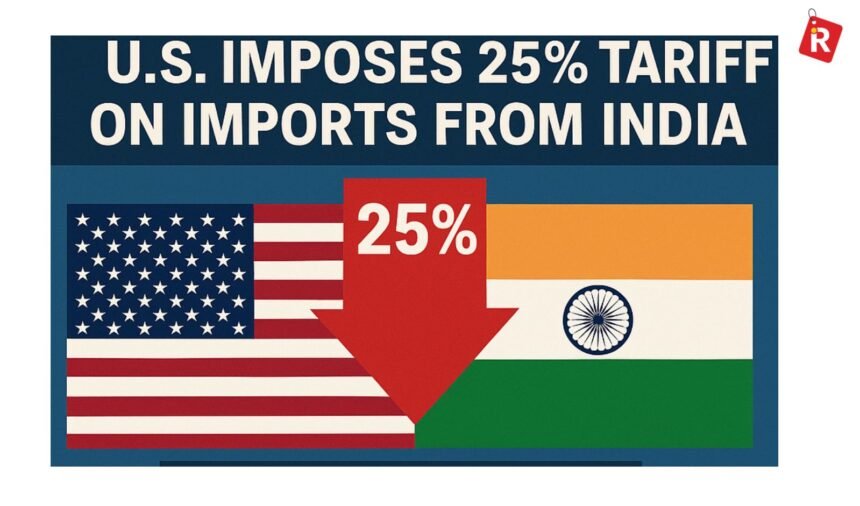U.S. President Donald Trump announced a 25 percent tariff on imports from India, along with an unidentified penalty in response to India’s ongoing trade in oils and military equipment with Russia. These measures, effective this week, are likely to disrupt India’s trade with the U.S. While this policy will impact many sectors, five key industries will likely be hit the hardest because of this decision. Here’s a closer look at the sectors most vulnerable to the new U.S. tariff regime:
1. Textile and Apparel Industry
The United States accounts for nearly 28 percent of India’s total textile and garment exports, making it one of the most critical markets. India exported over $10.5 billion worth of textiles to the U.S. in FY25. Companies like Welspun Living, Trident, and Arvind Ltd. are top exporters that depend on American demand for cotton towels, bedsheets, and apparel.
Impact
The 25 percent tariff is expected to erode price competitiveness, especially for cotton garments, which make up a large share of exports. According to CRISIL Ratings, Indian textile exporters may see margins shrink by 150 to 200 basis points if orders are changed or renegotiated under new prices.
2. Pharmaceuticals
India is a major global supplier of affordable generic medicines, with the U.S. as its largest pharma export market, taking in 40 percent of total pharmaceutical shipments. Exports to the U.S. rose from $8.1 billion in FY24 to $9.8 billion in FY25, driven by demand for chronic therapy drugs and cost-effective formulations.
Impact
Although pharmaceuticals often face different treatment in trade negotiations, it is likely that non-tariff barriers, such as stricter quality checks and regulatory audits, could rise. Additionally, U.S. buyers might raise issues related to intellectual property or pricing to pressure Indian manufacturers, particularly for high-volume generics. While essential medicines may still get some exemptions, securing new supply deals could become difficult.
3. Auto Components
India exported $2.2 billion worth of auto components to the U.S. in FY24, accounting for nearly 29 percent of its total exports in this category. These include transmission systems, engine parts, castings, and electronics used by American OEMs and aftermarket distributors.
Impact
The auto component industry operates with tight cost structures and competitive pricing. Tariffs will likely increase end costs for U.S. buyers, making Indian suppliers less appealing. According to the Automotive Component Manufacturers Association (ACMA), even a 10 to 15 percent decline in orders could result in production cuts and job losses, especially in Tier II and Tier III cities. The U.S. market is difficult to replace due to its demands for volume and technical specifications.
4. Steel and Aluminum
Indian steel exports to the U.S. reached $6.2 billion in FY25, driven by rising demand for construction-grade steel, engineered components, and finished products. India also exported $860 million worth of aluminum and aluminum products, including rolled sheets and extrusions.
Impact
Although the Indian steel industry operates on diversified exports, the U.S. remains a crucial market due to its infrastructure spending. A 25 percent tariff could significantly curtail growth, especially for MSMEs supplying engineered components. Indian exporters may also face anti-dumping investigations and national security-related restrictions under Section 232 of U.S. trade law. Margins and market share in the U.S. could decline quickly without acquiring exemptions.
5. Solar Equipment and PV Modules
India has become a key supplier of photovoltaic (PV) modules to the U.S., especially after Washington restricted Chinese solar products. According to the Institute for Energy Economics and Financial Analysis (IEEFA), in FY24, 99 percent of India’s PV module exports went to the U.S.
Impact
Any penalties on solar equipment, whether from tariffs or regulations, would directly affect Indian firms like Waaree, Adani Solar, and Tata Power Solar, which have recently increased capacity based on U.S. demand. With such a strong dependence on the U.S. market, Indian solar exporters may face sudden revenue losses unless they quickly shift focus to Europe or Southeast Asia.
The new U.S. tariff measures indicate a firmer trade position against India at a time when both economies are closely linked in manufacturing, services, and energy. While diplomatic negotiations are likely to continue behind the scenes, exporters will feel the immediate impact, especially MSMEs and labor-intensive sectors.
As the Indian industry responds to the announcement, success will depend on diversifying markets, product lines, and pricing strategies. Meanwhile, businesses and policymakers must collaborate to protect strategic sectors from sudden policy changes and ensure long-term competitiveness in global trade.
